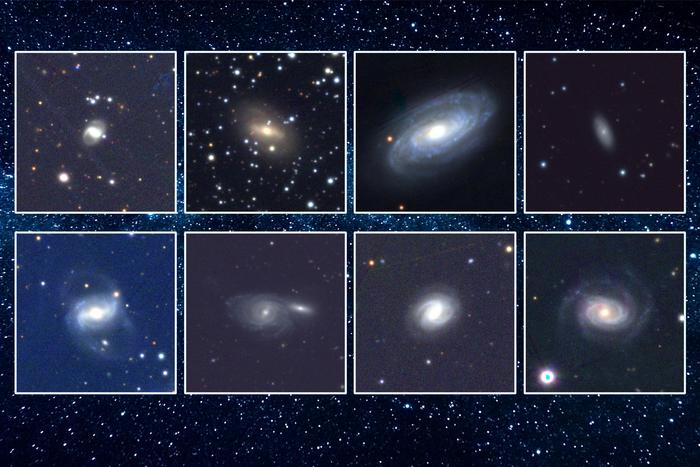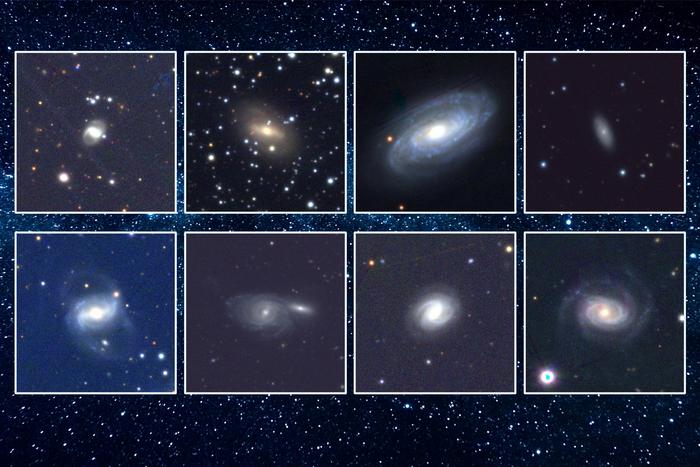The work shows tidal disruption events are more widespread across different types of galaxies than previously observed.

Credit: Courtesy of Megan Masterson, Erin Kara, et al
At the heart of nearly all large galaxies lies a supermassive black hole (SMBH). Some of these black holes may be steadily feeding on surrounding gas and dust, while others lie incognito with barely any material to eat. But no type of meal gets a black hole to light up its surroundings quite like an entire star. If one falls into a black hole’s grasp, the black hole’s gravity induces tidal forces that shred the star, flinging material outward and emitting light and radiation.
To date, astronomers have usually detected these tidal disruption events (TDEs) as a burst of either visible light or powerful X-rays. But a team led by researchers at the Massachusetts Institute of Technology has found 12 star-shredding supermassive black holes by searching instead in infrared light. The study, published Jan. 29 in The Astrophysical Journal, opens a new avenue for studying TDEs and shows that they are more widespread across different types of galaxies than previously observed.
Infrared light is useful to astronomers because it can penetrate clouds of galactic dust that can block visible light and X-rays, obscuring TDEs from view. “The majority of these sources don’t show up in optical bands,” said Megan Masterson, study lead author and graduate student at MIT, in a press release. “If you want to understand TDEs as a whole and use them to probe supermassive black hole demographics, you need to look in the infrared band.”
Shrouded in dust
Before this work, most TDEs had been found in a type of galaxy called post-starburst galaxies — galaxies that have recently experienced an intense episode of star formation and gone quiet. But starburst episodes also tend to clear out a galaxy’s dust. This left astronomers wondering whether starburst events naturally cause more TDEs or if we are simply missing out on detecting TDEs in dustier, star-forming galaxies because the dust makes them harder to spot.
Searching for TDEs in infrared light offers an alternative to optical and X-ray surveys. When a black hole tears a star apart, the TDEs should generate infrared light. The galaxy’s surrounding dust also heats up, creating detectable infrared radiation.
The team made its first detection of an infrared TDE in 2023 by looking at archived observations of short bursts of light taken by NASA’s NEOWISE mission — a space telescope originally designed to hunt for asteroids and comets in our solar system. They followed up on that find by using an algorithm to sift through all the data. They were able to identify 18 TDE candidates where the amount of infrared light temporarily surged. They whittled that list down to 12 after finding evidence that 6 of those candidate galaxies may be actively feeding on material from a preexisting disk of material around the black hole, not a single star.
The team says their haul of infrared-only TDEs shows that TDEs are happening in different types of galaxies, not just post-starburst galaxies. “If you looked up in the sky and saw a bunch of galaxies, the TDEs would occur representatively in all of them,” Masteron said in a statement. “It’s not that they’re only occurring in one type of galaxy, as people thought based only on optical and X-ray searches.”
The find helps astronomers understand how often supermassive black holes gobble up stars in any galaxy by bringing observations more in line with predictions. Researchers have predicted that on average, a galaxy should experience a TDE once roughly every 10,000 years, but the known rates from optical and X-ray surveys amount to less than half of that. The new TDE observations suggest that infrared TDEs are about as common as either optical or X-ray TDEs, bringing the total observed rate of TDEs significantly closer to the predicted rate.
In the long run, astronomers hope to be able to use TDEs as tools to measure the fundamental properties of their supermassive black holes, which is impossible to do directly. Better understanding the full population of TDEs through infrared observations is one step toward that goal.

